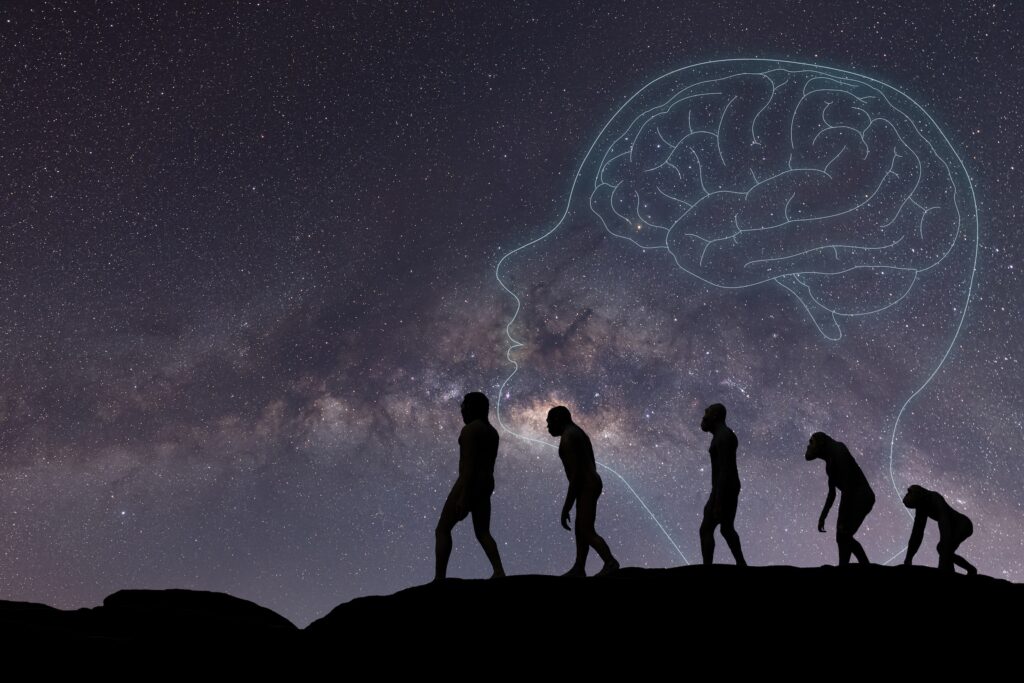Fitting theism in the natural frame
Reading | Theology
![]() Joshua Farris, Rev., PhD, CSM, CSPO | 2023-03-05
Joshua Farris, Rev., PhD, CSM, CSPO | 2023-03-05

The ‘hard problem of consciousness’ demands an expansion of the naturalist understanding of reality that may allow for some form of reconciliation between science and theology, argues Rev. Dr. Joshua Farris.
I’ve recently attended a summer study and conference on the topic of “Naturalism and the Religious Worldview” in Croatia, put on by the Humane Philosophy Project. As you might imagine if you are familiar with debates in science and religion, these are often framed as incompatible partners. But not only is there ongoing interest in exploring the relationship between the two, in fact there is a recent movement afoot that attempts to take a step further by reconciling the two perceptibly incompatible worldviews. The picture that comes to mind is of my wife’s Boxer dog trying to fit in the doggie door (intended for small dogs); it just doesn’t seem to work. Let’s consider the development of Naturalism and Religion.
Theology
Theology you might take to be the study of God’s nature and, especially, his acts in creation. In a classical understanding, the study of God boils down to the study of primary and secondary nature. All things are related to God as the primary referent of study, and his creation is a study of that which is a secondary act, which only analogously tells us something about the divine nature (his characteristics; or in an Eastern understanding, his ‘energies’). But this is strikingly distinct from the purported object of study as conceived in Naturalism.
Granted, anyone familiar with the study of Naturalism—and my students will attest to this fact—knows that in contemporary studies it—Naturalism—is notoriously hard to define. And it is not hard in the way that all philosophical concepts are difficult to define, but it is uniquely so because the boundaries have been so expanded that the term has become rather porous.
A survey of naturalism
In the early twentieth century, American analytic philosophers defined it as a thesis committed to the natural world of biological organisms, particularly Darwinian evolution, often with a commitment to the exclusion of any ‘spooky’ entities like God, spirits, angels, and things like ghosts. Ancillarily to this, there is often a commitment to what is called the “scientific method”—perceived as it is to be the rigorous process of empirical testing of phenomena. One might describe the view as falling under three broad types. The first is Metaphysical Naturalism, the second Epistemological Naturalism, and the third Methodological Naturalism—i.e., the scientific method.
In short, Metaphysical Naturalism is “the view that everything is or is grounded in the kind of entities studied by fundamental physics.” Epistemological Naturalism is “the investigative practice of studying the natural world by prizing the a-posteriori approach”[1] [Editor’s note: a-posteriori knowledge is knowledge that can only be gathered through empirical experience, and not logically deduced a priori.]. Methodological Naturalism is the study of the objects of physics and biological organisms.
Metaphysical Naturalism is standardly defined as affirming that: only nature exists; nature has always existed or simply popped into existence; nature is deterministic at one level; nature is purely physical (the natural entailment from its physical basis in particles); and finally, nature is a self-explanatory system. Correspondingly, Evolutionary Naturalism is defined as that which is physical and explained by physical causes and effects through adaptation, genetic drift, and other evolutionary mechanisms. Theism, in this definition, is immediately ruled out as misfit. It just doesn’t fit, like the boxer trying to fit in a small doggy door.
But then, there is Epistemic Naturalism, a practice guided by a set of methodological principles that takes it that the surest way of knowing is funneling everything through the rigorous empirical method (Francis Bacon often comes to mind as the earliest proponent of such a view). In such a view, not only is the a-posteriori method prized, but the a-priori method is suspect.
One way of defining Naturalism, generally, comes from the famous philosopher Thomas Nagel. He defines it along similar lines as Evolutionary Naturalism, given above, particularly highlighting the non-teleological nature of Nature. He states:
The profoundly nonteleological character of this modern form of naturalism is concealed by the functional explanations that fill evolutionary accounts of the characteristics of living organisms. But any reference to the function or survival value of an organ or other feature is shorthand for a long story of purposeless mutations followed, because of environmental contingencies, by differential reproductive fitness—survival of offspring or other relatives with the same genetic material. It is in the most straightforward sense false that we have eyes in order to see and a heart to pump the blood. Darwinian natural selection could be compatible with teleology if the existence of DNA had the purpose of permitting successive generations of organisms to adapt through natural selection to changes in the environment—but that, of course, is not the naturalistic conception. That conception, far from offering us a sense of who we are, dissolves any sense of purpose or true nature that we may have begun with. The meaning of organic life vanishes in the meaninglessness of physics, of which it is one peculiar consequence. It is widely thought that, without knowing the details, we now have every reason to believe that life arose from a lifeless universe, in virtue of the basic laws of particle physics or string theory or something of the kind, which did not have life or us “in mind.” If this is the case, then it is difficult, nigh impossible, to see how God could fit into this picture.[2]
However, not so fast! Some naturalists have expanded its boundaries so much that it fails to fit so neatly into the definitions given already. Lynne Rudder Baker describes an expansive, non-reductionist Naturalism she calls Liberal Naturalism, which loosely impacts epistemic access: “I suggest that liberal naturalists not locate their naturalism in entities lacking causal powers but rather espouse naturalism only in the sense of ‘pertaining to the natural realm.’ In that way, they could be more liberal than nonreductivists like Kornblith and still be naturalistic.”[3] The question with which Baker leaves the reader in her fascinating book, Naturalism and the First-Person Perspective, is whether Naturalism is disenchanted or optimistic.
There are myriad sets of interrelated problems with Naturalism, generally, like the problem of definition. But there is a more fundamental problem with it: namely, what some have called the intuitive problem of folk psychology.
The intuitive problem with the naturalist attitude
The common problem with Naturalism, or the naturalistic attitude as I call it, is that it fails to account for that which is most obvious to us in our experience of the world. This is what some will call the intentional attitude, consciousness, or simply experience of what it is like to be in relation to the world. Instead, it either eliminates the intentional attitude or it eschews it to such an extent that it becomes irrelevant to knowledge and no longer holds the primacy of place in how we come to know the world.
The intuitive problem is, simply put, a problem of reconciling the natural or scientific attitude giving primacy of place to the empirical method with that which is most apparent to consciousness. Consciousness is a term for what it is to be aware of. It is inclusive of properties of what it is like to experience in general. In other words, it is the difference made between that which constitutes the green grass in my yard (e.g., the properties of particle physics and ecology that come to comprise the grass and all that include it; namely, the dirt, the roots, and the blades themselves) and the experience of that grass, often described by what it is like to see the shape, the color, and all that surrounds it. Thomas Nagel calls this “subjective appearances.” The reality of our subjective appearances is so undeniable that it takes primacy of place over the constituent parts that undergird the physical reality studied by science.
David Chalmers deems these “subjective appearances” irreducible to physics or biology, a problem he refers to as the “hard problem of consciousness.”[4] In this way, consciousness is a phenomenon that biology and physics are unable to capture. We need more than physics and biology to capture it.
Thankfully, we are beginning to see this turn in science where consciousness (i.e., the intuitive move or the folk turn) is taking up space, once again, in the literature. Ironically, the naturalist attitude is re-presenting itself, but whether it can make sense of the “intentional attitude” is again up for debate in a fresh new way.
The theological turn in science
The theological turn in science is characterized by this move to reconsider not only the “intentional stance” often characterized by consciousness, but more than that, the openness to theology itself as a paradigm shift toward God as having, once again, an explanatory role in our understanding of the world. Some in the theological turn are attempting to re-envision the naturalist attitude in a way that gives credence to the natural world, the study of the objects of physics, and the empirical (i.e., a-posteriori) method as primary. They are now expanding the boundaries of Naturalism to include God and consciousness. Are they successful? That is yet to be seen. But I have serious reservations, since this privileges the following:
- The scientific method (i.e., Methodological Naturalism).
- Natural law.
- Biological generation as an originative explanation for all organisms.
This also means not privileging the mind, intentionality, the first-person perspective, or consciousness.
In fact, some of the main proponents of this new endeavor are clear that the common privileging of the mind, consciousness, the first-person perspective, etc., in philosophy and theology needs re-envisioning because this characteristic is often what has created insuperable problems for progressing the discussion between science and religion. These proponents include most notably Sarah Lane Ritchie, Christopher Knight, and others. They believe that what underlies the challenges for integrative science and religion projects follows from the dubious ‘intuition’ that the mind and brain are dualistic entities. In other words, the supposed hard problem of consciousness stands underneath the tension between science and religion as reflected so clearly in the recent accounts to find God acting at the joints between consciousness and the natural world (i.e., causal joint theories). By bringing God and nature closer together, they suppose we can construct newer theories that avoid God’s messing about ‘unnaturally’ in nature’s regular law-like way. These rely on the unnecessary assumption of some sort of non-physicalism regarding God, the mind, and action.
Without offering a full-blown critique of these projects, it is worth advancing some concerns. First, the challenge of intuitions calls into question the veridicality of intuition itself. Ironically, the affirmation that the scientific method (i.e., Methodological Naturalism) should be privileged in some way concerning knowledge depends on intuition. Second, by not privileging the mind, consciousness, and the first-person perspective, the leaders of Theological Naturalism not only import intuitive ideas of God, humans, and actions that, on the surface, appear inconsistent with their projects, but these rather important terms become insufficient designations for which we have little to say. Third, with all the problems customarily associated with Naturalism, as suggested above, it’s hard to conceive of theology being fitted to a Naturalism frame. Once again, my wife’s boxer trying to fit into a small doggy door just will not work. But is that what we are left with? I don’t think so, and I certainly hope not.
A better way
Surely, there is a better way than fitting a square peg in a circular opening. Science construed along naturalist lines, according to the naturalist attitude, obscures that which is central to the world. Minds are central and deserve not only a place at the scientific table but must be brought into our engagements with scientific endeavors. This requires, however, an expansion not of the boundaries of nature so as to capture mind, agency, and God, but to understand nature in light of the mind, agency, and God.
Some in recent science and religion literature have argued that, at best, Methodological Naturalism could be operational with a small set of data studied in a lab (what you might think of as operational science), but even the findings here would be quite limited in its explanatory value.
An alternative approach advanced by Benedikt Paul Gocke is that we should expand our understanding of science in such a way that both philosophy and theology fall under a broader definition of science, which takes into account all aspects of proper rational principles and values in the process of systematically making sense of the world. This, of course, affirms that minds are central and the often-disregarded a-priori method must be re-employed as we consider the natural world because, after all, mind is fundamental to nature.[5]
For a new project pursuing this sort of reflection, see here: https://designtheology.org/conference-registration
Notes
[1] These working descriptions are common in the literature. For further explanation, see the helpful article: Papineau, David, “Naturalism”, The Stanford Encyclopedia of Philosophy (Summer 2021 Edition), Edward N. Zalta (ed.), https://plato.stanford.edu/archives/sum2021/entries/naturalism/.
[2] Thomas Nagel, Secular Philosophy and the Religious Temperament (Oxford: Oxford University Press, 2010), 15, 16. Also see: Papineau, David, “Naturalism”, The Stanford Encyclopedia of Philosophy (Summer 2021 Edition), Edward N. Zalta (ed.), https://plato.stanford.edu/archives/sum2021/entries/naturalism/. [accessed on August 10, 2022].
[3] Lynne Rudder Baker, Naturalism and the First-Person Perspective (Oxford: Oxford Uinversity Press, 2013), 17. She generally agrees with De Caro and Voltolini’s ( 1 ) the claim that no entities can violate the laws of nature, and (2) the clam that “ontology should be shaped by natural science alone.” To not allow entities that violate the laws of nature is to not allow entities with causal powers without coming from the natural science. See also De Caro, Mario and Alberto Voltolini, “Is Liberal Naturalism Possible?” in Naturalism and Normativity ed. by Mario De Caro and David Macarthur (New York: Columbia University Press, 2010), 76. Of course, also see David Papineau in his Stanford Article on “Naturalism”. Also see the following select key figures: Pereboom, Quine, Steven Pinker, Galen Strawson. This is a long and fascinating discussion here. In more recent mainstream literature Ray Kurzweil and Novel Harrari develop optimistic accounts through the lens of transhumanism. Meghan O’Gieblyn develops a somewhat agnostic view with a disenchanted outlook that pervades most of the writing in God, Human, Animal, Machine (New York: Doubleday, 2021).
[4] David Chalmers, ‘Facing up to the Problem of Consciousness’ in J. Shear, ed., Explaining Consciousness: The Hard Problem (Cambridge: MIT Press, 1997), 18-19. Josh Weisberg, “The Hard Problem of Consciousness,” Internet Encyclopedia of Philosophy. https://iep.utm.edu/hard-problem-of-conciousness/ [accessed on Friday October 7, 2022].
[5] Thanks to the Humane Philosophy Project for inspiring this short article and to the Alexander Von Humboldt Foundation and Göcke, the Chair of Philosophy of Science and Philosophy of Religion for the time and space to work on this.

Essentia Foundation communicates, in an accessible but rigorous manner, the latest results in science and philosophy that point to the mental nature of reality. We are committed to strict, academic-level curation of the material we publish.
Recently published
Reading
Essays
Seeing
Videos
Let us build the future of our culture together
Essentia Foundation is a registered non-profit committed to making its content as accessible as possible. Therefore, we depend on contributions from people like you to continue to do our work. There are many ways to contribute.















